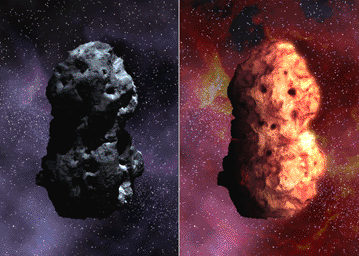
|
Space Eyes See Comet Tempel 1 (Artist’s Concept)
- Click the image above for a larger view
 Movie Download Options
Movie Download Options- Full-Res JPEG (2696 x 1921) (445.7 kB)
- Full-Res TIFF (2696 x 1921) (15.6 MB)
Caption:
|
These artist's concepts of Tempel 1 simulate an optical view of the comet (left), next to the simulated infrared view (right). The images illustrate the comet's shape, reflectivity, rotation rate and surface temperature, based on information from NASA's Hubble Space Telescope and Spitzer Space Telescope.
Measurements from the Great Observatories indicate that the comet is a matte black object roughly 14 by 4 kilometers (8.7 by 2.5 miles), or about one-half the size of Manhattan.
At the time of these early observations, March 25-27, 2005,Tempel 1 was still far enough away from the Sun that it had not yet developed its characteristic halo of evaporating gas.
Hubble and Spitzer observed the comet in visible and infrared light, respectively. The comet appeared only as an unresolved dot due to the great distance, but its general shape, size and color could be deduced from the way the visible and infrared brightness varied over time.
The animation simulates an optical view of the comet, followed by its appearance in infrared. Spitzer detects the comet's infrared energy or heat, depicted by the reddish glow. The movement of the comet has been dramatically sped up to 13 seconds per rotation versus its normal rotation of about 40 hours. As the comet slowly rotates, the sunlit side heats up while the dark side cools down.
Cataloging Keywords:
| Name | Value | Additional Values |
|---|---|---|
| Target | 9P/Tempel | |
| System | Periodic Comets | |
| Target Type | Comet | |
| Mission | Deep Impact | Hubble Space Telescope (HST), Spitzer Space Telescope |
| Instrument Host | Deep Impact | Hubble Space Telescope, Spitzer Space Telescope |
| Host Type | Impactor | Space Telescope |
| Instrument | ||
| Detector | ||
| Extra Keywords | Artwork, Color, Infrared, Movie, Rotation | |
| Acquisition Date | ||
| Release Date | 2005-06-02 | |
| Date in Caption | ||
| Image Credit | NASA/JPL-Caltech | |
| Source | photojournal.jpl.nasa.gov/catalog/PIA03516 | |
| Identifier | PIA03516 | |


